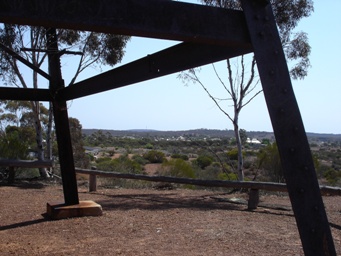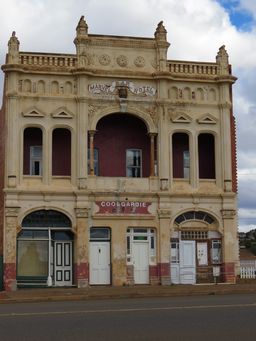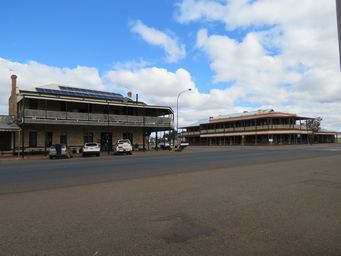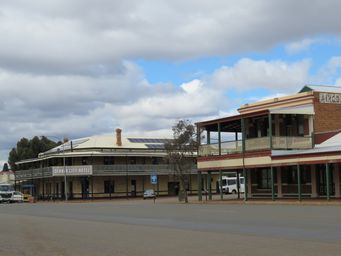Australia So Much to See
Hotels in Coolgardie, with thanks to Moya of Outback Family History for much of the history of these buildings.
Two early hotel buildings
remain on the main street on the eastern edge of town. Originally there were four hotels here, taking advantage of the proximity
to Fly Flat.
Coolgardie Original Cemetery, walk from Jobson Street near Forrest Street intersection, or from corner of Lyon Street, either way
approximately 300 metres. Used from 1890 to 1894.
Two places of interest we missed, on the western side of town:
Coolgardie
Pioneer Cemetery, from Great Eastern Highway one kilometre western side of town, opposite the former Haven Caravan Park. There are
over 3,000 graves here, the majority due to the typhoid epidemic, many of them unnamed. A significant grave in the cemetery
is that of Australian explorer Ernest Giles who spent his later years in Coolgardie. See Ernest Giles travels at the Longreach
Stockmanís Hall of Fame.
Original Coolgardie Racetrack. Scrub now covers this area, where races were held
until World War II intervened. Only two old posts remain, with a stone monument to mark the spot. Since 1943, the Coolgardie
Race Club has shared use of the Kalgoorlie-Boulder Racecourse. This can be accessed, leaving the Great Eastern Highway, turning
south opposite the Camel Farm turnoff, three kilometres west of the town. This track passes where the pipeline branches into
Coolgardie. The track appears to continue to meet # Gnarlbine Road to the south of the sport centre in Jobson Street.
# Gnarlbine Road continues south becoming the Victoria Rock Road. See our travels to Gnarlbine soak and well, Victoria
Rock and the Woodlines.
The Cremorne Hotel was originally a Hop Beer shop owned by Harry Horst and his wife who built the present building which they were
forced to relinquish due to ill-health. In 1896, when the dining room was demolished, five ounces of alluvial gold was found. Three
months later, in March 1897, the foundation stone of Harry Feinís Cremorne Hotel was laid by the Mayoress, Mrs A.W. McDonald. Harry Fein, a former auctioneer, completely renovated the premises, laying out bars and rooms and renamed it The Prince of Wales Bar
and Dining Rooms.
Warden Finnerty's House - The Residency was built in 1895 for Coolgardie's first Resident Magistrate and Mining Warden, Irishman John
Michael Finnerty. It was constructed of local stone and brick with tall windows with louvered shutters, large verandahs and
a ventilated roof lantern for coolness, on Montana Hill, overlooking the town. It has been furnished with antique furnishings
and chinaware of the late 1890's. Due to limited days opening, please call the Visitor Centre on 08 9026 6090 to check the property
is open before visiting. We missed seeing this on our visits.
RV parking by Railway Station (now disused), free for 48 hours for self contained. Dump point and potable water nearby. Railway Station was operating a museum but this has been closed.
Public toilets in Coolgardie Park (voice activated) and
wheelchair accessible toilets in Tommy Talbot Park in Bayley Street are open daily from 7 am to 4 pm. There is a laundromat
in the former Railway Hotel building in Bayley Street. Shower at swimming pool in Coolgardie Park, free entry. Showers,
toilets and under cover barbecue area at the Road Train Assembly area on Lady Loch Road on the eastern edge of town have been added
since our visit. This is opposite the Vibe service station, which also offer showers (or they did) free with fuel purchase, otherwise
$3.
Other accommodation for those not equipped for camping, there is the Coolgardie Motel and the Denver City Hotel, both accessed from Bayley Street, and the Safari Inn, budget units well away from the Highway in Renou Street, where pets are welcome.
References
The former Railway Hotel Coolgardie (1898) was originally built as offices for a London merchant who came to Coolgardie during the
gold rush in the 1890s, year it was expanded and became a licenced hotel is not clear. The Railway Hotel building in Bayley
Street is one of the only four remaining hotel buildings in the town, which once had 26 hotels. The hotel was de-licenced in
the 1960s and was called The Railway Lodge, and at different times it has been known as Gold Rush Lodge, Ghost Inn Hotel, and Michelle
Lodge.
By 1927 the 26 hotels of Coolgardie had dwindled to four. The licencing board asked the four publicans to show cause as
to why their licences should not be cancelled. The Denver City and the Railway hotels were able to keep their licences but the
Westral and the Marvel Bar had their licences cancelled.
The Denver City Hotel was the # first hotel in Coolgardie and the first building on the site was in 1894. A more substantial
building was constructed which was destroyed by fire in 1897. The current building of two stories in the Federation style was built
in 1898. It was of brick and Ashlar stone and had no balcony or veranda.
# With the first building on the site of the Marvel
Bar Hotel around 1892, the Denver Hotel first built in 1894 may not have been the first hotel, but may have been the first licenced.
Several hotels were built between 1892 and 1895, and a few of these are claimed to be Ďthe firstí.
The Moran family has a Wagin connection, when James Maron moved from Coolgardie in 1921 and took over the first Wagin Hotel, subsequently
knowns as Moranís Wagin Hotel. Moran held the licence until his death in July 1967. It is believed that he held the
licence for a single hotel for the longest period in Australia. His family continued to run the hotel until December 2017 when
the liquor licence was relinquished.
A year later, in 1898, the hotel and adjoining Cremorne Gardens Theatre was taken over by Vincent and Lipman who made a number of
improvements including a polished floor for use as a ballroom and a gallery and a ladies robing room. The Cremorne continued to change
hands until 1918 when Mr and Mrs Steve Keale took it over, refurnishing it and opening a new dining room.







Lions Bicentennial Lookout. The Bayley's Reward Gold Mine headframe was moved to this hilltop lookout and picnic area
accessed from Hunt Street, giving views northwards over part of the town, and eastward across Fly Flat.
Photos taken 2007.